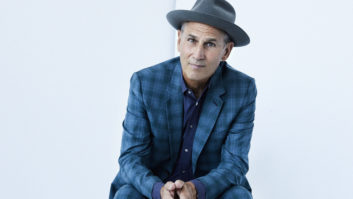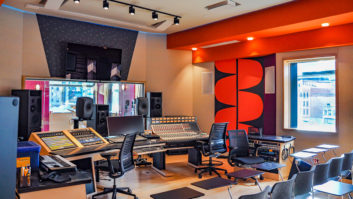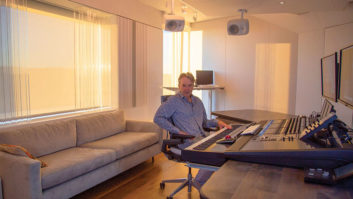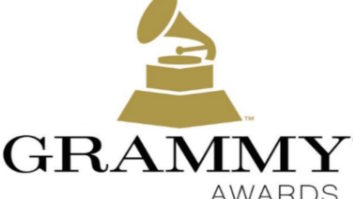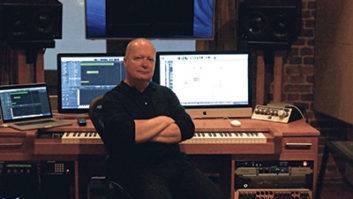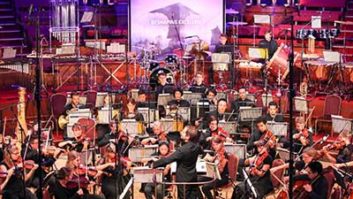In the world of classical music and the avant-garde, Philip Glass has long been an artistic force to be reckoned with. Many people probably know, or originally first heard, the prolific and groundbreaking composer through his soundtrack to the 1983 Godfrey Reggio documentary Koyaanisqatsi. Glass’ hypnotic use of arpeggios beautifully complemented Reggio’s slow-motion and time-lapse images of modern life in transition. Like other Glass works, the soundtrack beguiled many listeners, while drawing criticisms from others who felt that the music was redundant.
Glass has been deemed a minimalist by numerous critics, because many of his compositions feature repetitive, slowly evolving passages that tend to transfix listeners and make them lose their sense of time. The fact is, he is strongly influenced by Eastern music, and by bringing those aesthetic sensibilities into Western concert music, he has expanded the Western vocabulary.
With around 40 albums to his name, Glass cannot be conveniently placed into one niche. The proof is in his catalog, including his four-and-a-half-hour opera Einstein on the Beach, a landmark collaboration with scenarist Robert Wilson; his score for Bernard Rose’s beguiling 1992 horror film Candyman; his music for the 1984 Olympics; and his soundtrack to Martin Scorsese’s film Kundun, which spotlighted performances by the Gyuto Monks. Glass crosses over numerous boundaries in his music without sticking to a formula, even if there is an identifiable sound or style to many of his releases. Perhaps he is an acquired taste, but it is one that many people savor.
The Manhattan-based composer has certainly collaborated with a wide range of people, including musicians David Byrne, Laurie Anderson, Paul Simon, Suzanne Vega, former Doors keyboardist Ray Manzarek and the Kronos Quartet; dancer, director and choreographer Twyla Tharp; poet Allen Ginsberg; and filmmakers Martin Scorsese and Godfrey Reggio, among many others. Glass has written symphonies, operas, ballets, composed for film and theater, and even arranged pop songs. This is a man who wrote a new score for the classic 1931 film Dracula, composed a full opera for Edgar Allen Poe’s The Fall of the House of Usher and collaborated with Indian musical legend Ravi Shankar on the 1990 album Passages. He also turned two David Bowie/Brian Eno albums (Low and Heroes) into symphonies.
The Nonesuch label continues to keep the composer’s film music alive with the recent DVD-Audio reissue of Koyaanisqatsi and the five-CD box set Philip on Film: Filmworks by Philip Glass. And most recently, Orange Mountain Music was founded by Glass associates to exclusively release his works, including The Music of Candyman.
Being self-sufficient has undoubtedly aided his career longevity and artistic freedom. Since 1991, he has owned and recorded at Looking Glass Studios in New York (www.glassnyc.com). Many prominent pop artists have recently recorded albums there, including Suzanne Vega, Duncan Sheik, David Bowie, Bowie’s guitarist Earl Slick and Grace Jones. The studio is well-equipped: It has a 48-track G Series SSL console; Otari 2-inch, Pro Tools and Logic/G4 recording systems; and plenty of outboard boxes.
Still, though, Glass composes his music the old-fashioned way: with paper, pencil and brain power. In this revealing interview, he discusses his methods and motives, and his life as a progressive composer forever going against the grain.
You strike me as someone who sits at the piano for a very long time to work everything out before going into the studio.
I do a lot of working out, that’s very true. And by the time I have it down on paper — paper and pencil, I’m still working that way — then I turn it over to the people I work with, who work directly to hard drive. Basically, we go into recording mode right away.
Do you have a separate studio at home?
At home, I just have a piano and a table. And three blocks away is all the gear. Many days I don’t walk over there at all. I will go over there today, but many days I don’t go over there.
That’s interesting, because so much music today is studio- and technology-based. Many people are creating music but not composing it. They’re sculpting it within their computers now.
That’s not so true of what we call concert music. In the world of concert music, I am the maverick who has adopted the technology of the rest of the music world and used it in the creation of operas, ballets and symphonies. To the degree that I have my own facility that I work with, very few composers have a setup like this in the world of experimental concert music. In the world of film music or the different kinds of commercial music — and there are lots of different kinds of it — people are working directly in the studio.
You’ve been inspired by many different genres, which is great because ultimately I’ve found that so many of them are tied together.
That’s what we’re finding. Even the separations are becoming less meaningful. The big record stores still try to categorize things into pop and jazz and opera and all that stuff, but the audiences aren’t categorized that way. So in a way, I think the barriers between the genres are just dissolving.
I imagine that when you started composing 30 or 40 years ago, you probably found it to be very different.
Oh, it was very different. The idea of working in the studio was very remote. Composers didn’t work in studios except maybe if they got a piece recorded, which was not often. I’ve got about 40 CDs now.
I find it interesting that you can go from writing epic pieces like Einstein on the Beach or Music in Twelve Parts to working in films, because obviously you have to condense those musical concepts.
It’s a different way of working. It’s all stimulating. It keeps you fresh to keep changing that way.
Do you find it challenging to condense your musical ideas into a smaller time frame for these films?
And then the other way around, going back to an extended time frame. Like writing a little transition for a movie and then thinking about a scene of an opera that may be 10 or 15 minutes long. Or a slow movement of a concerto that could be 15 minutes long, and then turning around and doing an arrangement for David Byrne that’s got to be over in three minutes!
I think we develop facility and a kind of distance and objectivity, in a way, about the work when we develop that kind of flexibility. I think it’s extremely positive to work that way.
Do you use click tracks when recording your music?
It depends. Sometimes we do, sometimes we don’t. Some things are done best that way. When we’re doing music live to a film, we don’t use a click track. That is synchronized visually to the film. For live performances, I never use a click track.
In the studio, it can be very useful, but we don’t use a steady click track. We sometimes construct a click track that speeds up and slows down, so that when you’re playing with it, it gives room for a different kind of expressivity.
You have been very comfortable working with conductor Michael Riesman over the years. How much influence has he exerted on your work?
The main influence is that he has given me tremendous flexibility in what I can do. He brings a tremendous expertise to mixing and recording. Very often, I’m writing a piece that’s both a recording and a live performance. I know that we’re going to record, and then I know that we’re going to play it live like a film score. And I’ll say to Michael, “How many instruments can we use for the live performance?” And he’ll say, “Don’t worry about that. Write whatever you want to write and let me figure it out.” So I do. Then we’ll look at the score together and figure out how to make it work best, whether we’re going from recording to live or live to recording. It could be either way. So he gives me a tremendous amount of flexibility in what I do. It’s really terrific.
You have a five-CD box set out on Nonesuch called Philip on Film that collects many of your film scores. Is there any one of these soundtracks in the box set that is your favorite?
Always the new ones. Because they’re new. The new ones are the pieces that we call shorts. They’re short films made by Atom Egoyan, Shirin Neshat and Godfrey Reggio [and others]. So these are all movies that I’m very, very interested in. I enjoyed very much working with them. I worked collaboratively with all the filmmakers.
When you’re doing these soundtracks, how much influence do these directors have upon you?
It depends upon the filmmaker. With Godfrey, I’m given a lot of freedom. And I was with Marty Scorsese, too, with Kundun, which is not in that box [completely], but it was an important score for me. I try to get the filmmakers into a collaborative frame of mind where I can make real contributions and they give me the room to do that. That’s the best thing for me.
Have you found yourself influencing the way they make films?
In Godfrey’s case, I’ve written music and then he’s created the images afterward.
For which film?
The one we’re working on right now! We’re doing Naqoyqatsi, which is the third of the qatsi movies. There’s a little connecting piece that’s about three minutes long, and he hasn’t even made the images yet. He told me what it would be like and how it was going to function. I wrote some pieces, and we recorded them. After I talk to you, I’m going to go down to the studio and look at the first images that he’s put to it.
How will this film be different from Koyaanisqatsi and Powaqqatsi?
It’s extremely different in the way that the images were created. The images are mostly created from digital technology. If not, some were filmed and then they were revisited technologically, so that they ended up looking differently, processed in different ways. There is almost no image in the film that would appear the way it would have in a normal film. So he’s created a very different film language in terms of the visual language.
The story is the ongoing story that Godfrey has, which is the impact of modernity and technology on the way we live. It’s not always a critique of it. People think he’s very much against the modern, but he’s not actually. He’s just trying to present what he sees as the process that’s going on around us.
Tell me about Looking Glass studio.
We have two rooms. The A room is where we can do sessions with string sections and brass sections, and the B room is really an overdub room. We’ve had 2-inch analog [tape machines] for a long time, but everything is Pro Tools now. The rooms are also very good for mixing. The control rooms are fairly spacious so that you can be comfortable.
Do you own Looking Glass?
I own it, unfortunately. [chuckles] I had a partner a few years ago who left me, and I got stuck with it. That’s when I began renting it out commercially. And then I had to continually upgrade it to keep up with the level of technology in the business. We have very good engineers and people that are quite expert at digital stuff.
Do you do any pre-production in the studio or do you write everything at home?
The writing is all done at home. All I take over to the studio is pencil and paper, and then what we do often is, we’ll play all the music into a computer so that we can print out the parts for all the players. And at the same time, we can make the click tracks and everything we need to sequence. If it’s a film, we have to be prepared to use a SMPTE code of some kind.
As far as synthesizers, samplers, effects units and sequencers go, how much, if any of those, have you used in your music?
We use them all, actually! In the production, we can use everything. We may record an orchestra and then go back and sample strings and fill out the sound with that.
Your music is so organic, you probably don’t have lots of samples or restructured sounds.
Actually, there’s more than you might think. In fact, one of the things that Michael and [producer] Kurt Munkacsi are skillful at is making things sound very organic. Sometimes it’s painstaking work to get things exactly right, recording things over and over again. When you hear it, it sounds like it just happened in a second. That’s part of the art of what they do, to make it sound organic and natural, but, in fact, a lot of the work can be very technical.
Does that include editing different passages together?
Even that, you may have seven or eight alternate tracks of the same measure. If you’re doing a singer, you may record the same phrase a number of times, and then you’ll put together the best performance. It sounds funny if you explain it to people who aren’t involved in the business. It sounds very technical, but the result can be an extremely beautiful vocal line that would never actually have happened in the real world.
The devious aspect to Pro Tools is that some people can get addicted to the technical side and not pull away to let the music breathe, because they want to make things sound perfect.
I think we a have good balance because we’re also very involved in performance. Michael and I are often on the road. I do 60 to 80 concerts a year, so I’m constantly involved with the organic reality of live performance. So that becomes a balance. It helps, I think, to have that experientially in your mind when you’re in the studio.
You obviously have a signature style that some people love and others dislike. Are you ever aware, especially considering your large body of work, that you’re writing a “Philip Glass piece”?
The language has changed slowly over 30 years. If you listen to Music in Twelve Parts and Kundun, they sound like they were written by different people, but I can hear myself in it. I’m always struggling with that. I think any artist is struggling to renew their style, and it’s not easy to do. Some things you’ll never break free of. To reinvent yourself, like the way you talk or the way you walk, is very hard to do. But I think if you work at it, you can maybe do it, if you keep enough doors and enough windows open so that the language can refresh itself from time to time and take on a different meaning.
Many of your pieces have cyclical arpeggios in them. What do you find so mesmerizing about them?
When I began it, it was a way of combining harmonic and rhythmic language in the same structure. That’s what that was. I just wrote a symphony where there are no arpeggios at all. It’s gone. And there are very little in Kundun.
Do you find any irony, even some pleasure, in the fact that when you started out, you were ruffling the feathers of some of the conservative classical establishment, and now you could be considered a pop culture icon?
Well, that may be, but I still can’t play in every opera house that I’d like to. The classical world is a very slow world to change. I simply worked around it and found ways of playing in different places. I think the work is recognized in a general way. There are still places where it’s not recognized at all. I have to put up with that. I probably always will.
Do you still feel like an outsider?
In some ways, yes. In some ways, no.
You’ve managed to make a lot of different music and work with a wide range of people.
The thing in America is that we recognize people with prizes and grants and academies, and I don’t belong to any of them. I never got any prizes or grants, and I don’t belong to any of the academies. Except the Academy [of Motion Picture Arts & Sciences]; that’s the only one I belong to. When I got nominated for Kundun, I automatically became a member. But I never got a Guggenheim, I never got a MacArthur.
Does it matter to you personally?
No. But what I’m saying is that kind of affirmation, which is important for a lot of people, I gave it up a long time ago, because I realized it was never coming my way. It wasn’t important to me.
On your Website, there is a quote attributed to you: “Most music begins with an introduction, then it develops and has all sorts of adventures, some happy, some sad, and then it finally comes out at the end.” How would you describe your own music?
It’s theater music. It’s really driven by subject. And the subject is not necessarily a narrative subject. It can be a portrait, an image. It may not be a story. It could be a story that’s told in a fragmented way. I describe my music as theater music because it involves image, text, movement and music, and the combination of these together is what interests me. I would say 70 percent of the work I do is theater music in that sense.
Visitwww.philipglass.comfor more on this composer.
